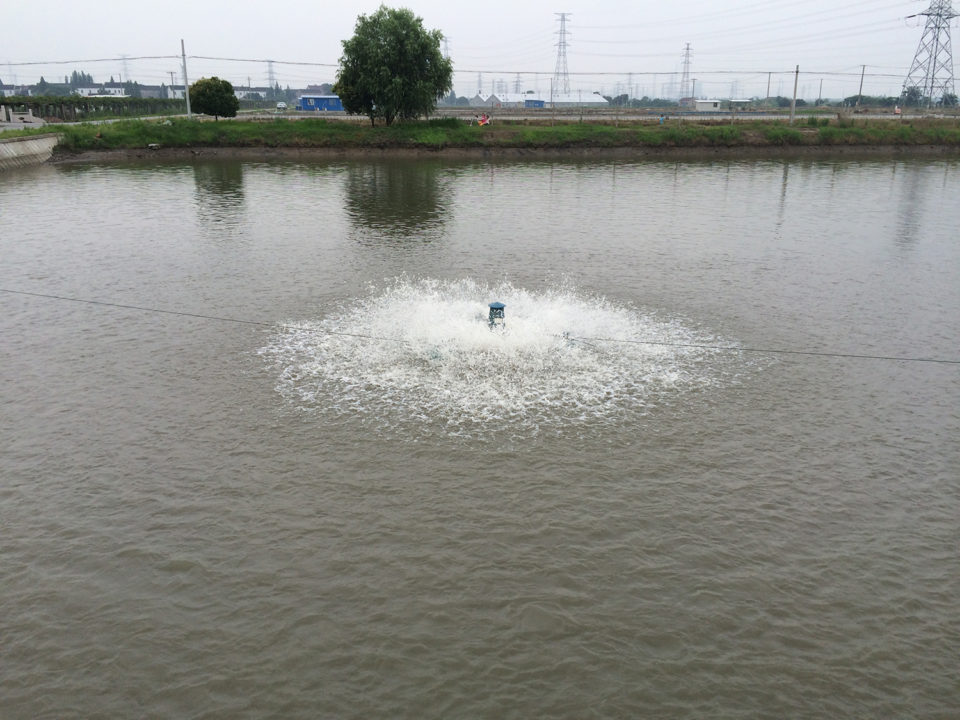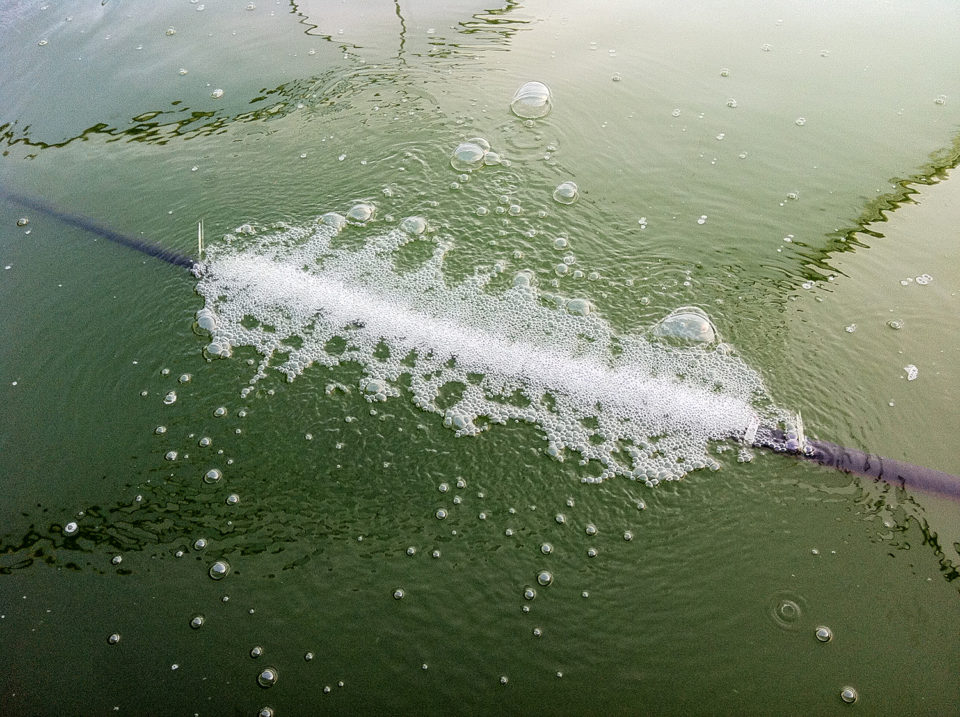Distributes oxygen, fertilizers, liming and other products, helps with destratification of water column

The water in aquaculture production systems should be circulated and mixed by the wind, and in more intensive systems, through mechanical means. In this article I will discuss why mixing is so important.
In aquaculture systems, there often are concentrated sources of the substances found in the water. Fertilizers and liming materials applied to ponds consist of concentrated mineral particles that dissolve. Concentrations of fertilizer nutrients and calcium and bicarbonate from fertilizers and liming materials reach equilibrium levels near the particles. This slows dissolution unless concentrations of dissolving substances near the particles decline by moving quickly away to prevent equilibrium from occurring. Nutrients and basic substances from fertilizers and liming materials, respectively, must also move through the water volume to be effective.
The air is a concentrated source of dissolved oxygen, but oxygen quickly enters the surface film of water and saturates it. The rate of entrance of more oxygen from the air depends upon the rate of movement of oxygen from the surface film to the water mass. Dissolved oxygen concentrations are increased by aeration devices, but if the oxygenated water does not move away, the elevated dissolved oxygen concentration around the aerator decreases aeration efficiency. Dissolved oxygen is produced by phytoplankton in the illuminated surface waters of ponds, but it must be moved by water currents to improve conditions in deeper waters near the bottom.
Phytoplankton often becomes abundant in surface waters, and scums of certain buoyant species form at the surface in still water. These organisms move with water currents, and mixing causes more uniform phytoplankton abundance throughout the water volume and minimizes algal scums.
Heat and diffusion
Heat moves through water by conduction from areas of higher temperature to areas of lower temperature. Other substances move by a similar process called diffusion. Particles of a dissolved or suspended substance continually collide with each other, and they also collide with other dissolved and suspended substances and with water molecules. These collisions result in deflection of particles in random directions.
In an area with a high concentration of particles of a particular substance, there are more collisions than in areas of low particle concentrations of the substance. This results in a natural movement of particles from an area of high concentration to surrounding areas of lower concentration. Particles of a substance migrate from high to low concentration, and eventually, a uniform concentration will result throughout the mass of water.
Diffusion is a very important process in moving solutes among cells of living organisms. But, even so, the movement of solutes within organisms is slow, and cells have active carrier mechanisms to accelerate the process. In an aquaculture pond with perfectly still water, it would require years for particles of a substance to diffuse from a concentrated source and reach uniform concentrations throughout the water volume.
Effects of wind
The wind produces water currents and tends to mix water bodies, but wind will not prevent thermal stratification in water bodies that have depth greater than a few meters. Ponds maximum depths of 3 to 4 meters may stratify for long periods in warm weather. Stratification is an unwanted consequence in aquaculture, because the upper, warmer, less dense layer of water (epilimnion) in which oxygen enters from the air and in which oxygen is produced by phytoplankton photosynthesis is separated from the deeper, cooler, denser water (hypolimnion). Sudden destratification of such water bodies can mix the oxygen-less bottom water containing reduced substances into surface water resulting in oxygen depletion.

Aquaculture ponds usually are constructed so all areas are more than 2 meters deep. Nevertheless, thermal stratification may occur during daytime, because turbidity caused by phytoplankton absorbs or reflects most of the incoming solar radiation within the upper 0.5 to 1.0-meter layer. Thermal stratification in shallow ponds collapses at night when surface water cools by convection. However, weak stratification that occurs during the day may result in impaired water quality near the pond bottom – especially lower dissolved oxygen concentration.
Aquaculture production has shown a tremendous trend of intensification during the past 20 years. This has resulted from greater use of fertilizers, liming material, feeds and other inputs. Wind mixing is not sufficient to prevent thermal stratification in many extensive and semi-intensive ponds, and in modern, intensive systems it certainly is not adequate to uniformly mix dissolved and suspended substances throughout ponds.
Wind also is not adequate to move metabolic wastes from areas of high concentration and mix them with waters of lower concentration for dilution. If this is not done effectively, certain areas of ponds will not be suitable for the culture species resulting in them congregating at higher density in areas of suitable water quality.

Movement of oxygenated water across pond bottoms
It is extremely important in ponds for there to be movement of oxygenated water across the bottom. Organic matter continually settles on the bottom and is mixed into the surface layer of soil by biological activity. The oxygen demand in sediment is high, and dissolved oxygen in the pore water can only move downward by diffusion and infiltration. The downward movement of oxygen in sediment is not as rapid as its rate of removal by organisms decomposing organic matter.
As a consequence, sediment seldom contains dissolved oxygen below a depth of a few millimeters. Anaerobic conditions may occur at the sediment-water interface in some organically enriched sediment. Such areas are avoided by shrimp and fish. Mixing of the pond should be strong enough to provide a current of oxygenated water across the pond bottom.
Mechanical aeration produces water currents, and enough aeration should be applied to mix the entire pond volume. This may be encouraged by positioning multiple aerators across the pond. However, care must be taken to prevent aerator-induced water currents from eroding the pond bottom and especially the inside of embankments. Plastic liners are particularly effective in preventing erosion of embankments. Soil particles eroded by aerators settle within the pond in zones of low water velocity. Accumulation of soil particles along with particles of organic matter create zones of poor water quality at the sediment-water interface which are avoided by culture animals.
We do not know the ideal water velocity within ponds or how to achieve a uniform water velocity using aerators. Some companies manufacture devices specifically designed to create mixing in water bodies. There has been some use of these devices to supplement aerator-induced currents in aquaculture ponds, but few data have been collected to ascertain the best way to position and use these devices. Even less is known about water circulator use in aquaculture than is understood about optimizing water circulation with aerators.
Author
-

Claude E. Boyd, Ph.D.
School of Fisheries, Aquaculture and Aquatic Sciences
Auburn University
Auburn, Alabama 36849 USA
Related Posts

Health & Welfare
Common salt a useful tool in aquaculture, part 2
The preventive use of common salt (sodium chloride) by commercial producers of freshwater fishes has many benefits, including helping with the routine prevention of losses due to diseases, stress and mishandling during transport, harvesting, grading, counting, weighing and induced spawning.

Responsibility
Efficiency of mechanical aeration
Although relatively expensive, mechanical aeration increases production. Asian-style paddlewheel aerators are widely used but are inefficient. Testing has led to more efficient designs that are now widely used in U.S. catfish and shrimp ponds.

Responsibility
Does Coriolis force impact aerator placement in aquaculture ponds?
The Coriolis effect has no bearing on aerator placement and aquaculture pond management. The most important consideration with mechanical aeration is to provide a sufficient amount to maintain adequate dissolved oxygen concentration.

Responsibility
Light penetration in water
Light penetrating water is scattered and absorbed exponentially as it passes downward. The presence of dissolved organic matter and suspended solids further impedes light penetration, and different types of solids absorb different wavelengths.

